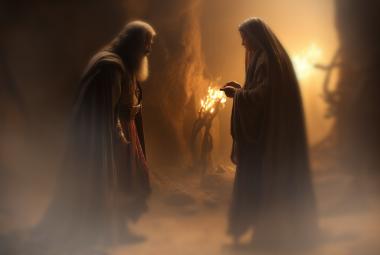Q: Who is Jesus referring to when he says, "...this generation shall not pass, till all these things be fulfilled"?
Now learn a parable of the fig tree; When his branch is yet tender, and putteth forth leaves, ye know that summer is nigh: So likewise ye, when ye shall see all these things, know that it is near, even at the doors. Verily I say unto you, This generation shall not pass, till all these things be fulfilled. Heaven and earth shall pass away, but my words shall not pass away. But of that day and hour knoweth no man, no, not the angels of heaven, but my Father only.
Matthew 24:32-36
This passage has given rise to more conjectures and still stimulates much confusion even today.
Israel as the Fig Tree?
It has been popular to presume that the "fig tree" is a reference to Israel. That view was further popularized by Hal Lindsey's best seller, The Late Great Planet Earth,1 and Ed Weisenant's 88 Reasons that Jesus would return in 1988. The idea was that since Israel was restored to statehood on May 14, 1948, and that a generation can be defended as 40 years, that 1988 was the year to watch.
(Hal Lindsey's book remains a classic in its field; Weisenant's book, I suspect, is available at rather deep discounts.)
Jerusalem as the Fig Tree?
Some have further suggested that the vine was the symbol for Israel, and that the fig tree refers to the city of Jerusalem. Around this conjecture, some suggest that June 6, 1967, is the key year when, as a result of the Six Day War, the Old City of Jerusalem returned to Israeli control. This would make the year 2007 a year to watch. (That may well be true for other reasons.)
Terminus A Quo?
The starting point for "this generation" is a key part of the enigma. The presumption that the idiom of the "fig tree" uniquely refers to either Israel or Jerusalem seems specious. The parallel account in Luke includes, "...and all the trees," which would seem to dismiss any specific metaphorical significance to the fig tree itself.2 Attempts to identify any really consistent specification of the fig tree as a denotative metaphor seems rather fanciful.
The direct clue to the real issue is the immediately following verse:
But of that day and hour knoweth no man, no, not the angels of heaven, but my Father only.
Matthew 24:36
That would seem to have in view the Harpazo, or "rapture" of the church,3 which is the principal event that is distinctively without precedent prerequisite events. It appears to be the trigger to the entire scenario. The removal of the church is also the event which removes the present blindness of Israel:4
For I would not, brethren, that ye should be ignorant of this mystery, lest ye should be wise in your own conceits; that blindness in part is happened to Israel, until the fulness of the Gentiles be come in.
Romans 11:25
This would also seem to be consistent with apparent "Jewish-ness" of the entire Olivet Discourse, of which this parable is a part. 5 The mutual exclusiveness of Israel and the Church is intrinsic to the structure of Gabriel's Seventy Weeks prophecy to Daniel. 6
(Much of the confusion among prophecy buffs is over ecclesiology rather than eschatology.)
The "Second Coming" is preceded by a "week" of seven specific years which even include a "mid-course" correction in the midst of the week. 7 From a careful exegesis of 2 Thessalonians 2, we learn that the removal of the church is a prerequisite condition to the appearance of the Man of Sin, the Son of Perdition. 8 Thus, the sequence appears as follows:
1.The Harpazo, or "rapture," of the church; 9
2. The public appearance of the Man of Sin.10
3. His coming to power sufficient to "enforce the covenant" with Israel for seven years;11
4. The Second Coming of Christ, which terminates the seven years.12
Conclusion
The Parable of the Fig Tree seems to indicate that the generation which sees the beginning of these things will see them all. But the triggering event may well be the Harpazo, the only prophetic event that is distinctively both unspecified and imminent.
Since there is a definite seven-year period immediately preceding the Second Coming, it would seem that there could be up to as many as 33 years (40 - 7) between the Harpazo and the beginning of the seven-year period for the Man of Sin to appear, rise to power, and position himself to enforce the covenant that Isaiah calls the "Covenant with Hell."13
These intervening years could also include the rebuilding of the Temple, the rebuilding of Babylon, and other anticipated positionings for the final climax.
To the extent that there are geopolitical and other signs on the horizon which suggest that the circumstances anticipated for the seven-year period are moving into position, these certainly support the view that the Harpazo is getting closer and may be on our very immediate horizon.
This should, indeed, intensify our priorities to immerse in the Word, reexamine our commitments to our Coming King, and seriously address each day which remains with a high degree of urgency.
Therefore be ye also ready: for in such an hour as ye think not the Son of man cometh.
Matthew 24:44
Are you really ready? Do you really take Him seriously?
Prove it.
Notes:
- Hal Lindsey, The Late Great Planet Earth, Zondervan Publishing House, Grand Rapids MI 1970, p.53-54. This book, published in over 35 languages, resulted in Hal being named as "The Author of the Decade," in 1980, by the New York Times.
- For an amusing use of allusions to the fig tree and others, see Abimelech's speech in Judges 9:6-15.
- 1 Thessalonians 4:17. "Caught up," (Greek harpazo: to seize, carry off by force; to seize on, claim for one's self eagerly; to snatch out or away.)
- This blindness was declared when they failed to recognize Christ's presentation of Himself as Messiah the King at His "triumphal entry," Luke 19:37-44. Note verse 42.
- Matthew 24:16, 20.
- Daniel 9:24-27.
- Daniel 9:27.
- 2 Thessalonians 2:3-8. For a detailed review see our Expositional Commentary on the Book of Thessalonians.
- 1 Thessalonians 4:15-17; 1 Corinthians 15:51-55.
- 2 Thessalonians 2:3-8.
- Daniel 9:27.
- Matthew 24:22.
- Isaiah 28:15, 18.






